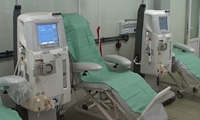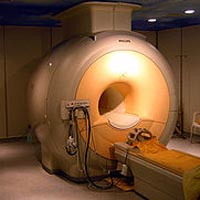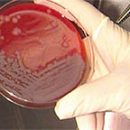Uremic coma develops with a violation of the functioning of the kidneys. The most frequent causes of the Uremic Coma are chronic glomerulonephritis and pyelonephritis. The accumulation of blood exchange products and a sharp decrease in the amount of urine allocated leads to the development of coma.
Content
Uremic Coma (Uremia) - umbrella - this state is due to endogenous (own occurring inside the organism) intoxication due to severe acute or chronic lack of kidney function.
Causes of the Uremic Coma
Renal failure can develop due to a number of reasons. Most often, the Uremic Coma is developing as a result of chronic glomerulonephritis or chronic pyelonephritis. Unpeacular reasons for Uremia can be poisoning drugs (sulfanimamides, antibiotics, salicylates and t. D.), industrial poisons (dichloroethane, ethylene glycol, methyl alcohol t. D.), transfusion incompatible blood, burns, indomitable vomiting and diarrhea, shock conditions and t. D.
With these pathological conditions, the kidney damage occurs, disorders develop in the kidney circulation system, as a result of which Oliguria occurs (the amount of daily urine does not exceed 500 ml) and Anuria (the amount of daily urine is less than 100 ml). The accumulation of toxic products of metabolism (urea, creatinine, uric acid in the body) causes the appearance of symptoms of Uremia. Delay in the body of potassium ions, sodium, chlorine, calcium, magnesium is the cause of the disorders of the acid-alkaline equilibrium and the blood pH shift in the acidic side, t. E. Development of metabolic acidosis.
Symptoms of uremic coma
 Uremic coma develops usually gradually. Patients are expressed by asthenic syndrome - apathy, general weakness, fatigue, headache, sleep impairment (sleepiness day and insomnia at night). All these phenomena are associated with the toxic effect of urea to the central nervous system. Disps syndrome manifests itself with a decrease in appetite up to anorexia (full failure of food), dryness and bitterness in the mouth, the smell of urine from mouth, thirst. Stomatitis, gastritis, enterocolit. All this is due to the presence of out-of-repair paths of removal of toxic metabolic products: through the mucous membrane of the gastrointestinal tract, the skin and sweat glands.
Uremic coma develops usually gradually. Patients are expressed by asthenic syndrome - apathy, general weakness, fatigue, headache, sleep impairment (sleepiness day and insomnia at night). All these phenomena are associated with the toxic effect of urea to the central nervous system. Disps syndrome manifests itself with a decrease in appetite up to anorexia (full failure of food), dryness and bitterness in the mouth, the smell of urine from mouth, thirst. Stomatitis, gastritis, enterocolit. All this is due to the presence of out-of-repair paths of removal of toxic metabolic products: through the mucous membrane of the gastrointestinal tract, the skin and sweat glands.
It is characterized by the appearance of the patients - the face is thought-out, the skin is pale, dry, with traces of calculations due to the painful itch, sometimes deposition on the skin of uric acid crystals in the form of powdered sugar. Characterized bruises and hemorrhage, pastosity of the face, the edema of the lower limbs and the lower back. Hemorrhagic syndrome under Uremia is clinically manifested by nasal, uterine and gastrointestinal bleeding, which is associated with damage to the vascular wall and thrombocytopenia (decrease in blood platelets).
Develop changes in the cardiovascular system. High hypertension appears (especially raised diastolic, lower pressure).
Violations in the respiratory system are manifested by the frequency disorder and depth of breathing, an approached shortness of breath, which may be a harbinger of uremic edema of the lungs due to the delay of salts and fluid and the development of acute left-delicate failure. Increment of intoxication leads toxic damage to the central nervous system and the transition of the inhibition and the opposite state in itself. Consciousness is lost, at the same time, periods of sharp psychomotor arousal with delirium and hallucinations can be observed. The oppression of the respiratory center leads to the appearance of Kussmouul's breathing - rare deep noisy breathing. With increasing comatose state, fibrillary twitching of individual muscle groups, pupils are narrow, tendon reflexes are increased. There are anemia, thrombocytopenia, leukocytosis (increasing the number of leukocytes), accelerated. Raising the level of residual nitrogen and urea, creatinine concentration. With acute renal failure, the proportion of urine is high, expressed albuminuria is determined (the presence of protein in the urine), macrohematuria (a large amount of blood in the urine), cylinder (presence in the urine of cylinders).
Treatment coma
 The most effective method of treatment of Ureodia is hemodialysis - the liberation of the blood of a patient from toxic metabolites with the help of the device «Artificial kidney». Hemodialysis is carried out by testimony. The procedure is carried out in a specialized hemodialysis department. From other types of treatment, disintellation therapy is carried out, the bloodletting of up to 400 ml of blood is used (contraindicated with pronounced anemia). Washed with a stomach with a warm solution of drinking soda, purify the intestine with siphon enemas; 5% glucose solution of no more than 500 ml, 200 ml of 4% solution of sodium bicarbonate is injected intravenously. The correction of electrolyte disorders is carried out under the control of the electrolyte composition of blood plasma. With a decrease in sodium concentration, 200-400 ml of isotonic sodium solution intravenously drip, with a decrease in potassium - 10% solution of calcium gluconate solution is re-introduced. In case of indoorable vita, 10 ml of a 10% solution of sodium chloride is injected intravenously, subcutaneously 1 ml of 2.5% aminezine solution.
The most effective method of treatment of Ureodia is hemodialysis - the liberation of the blood of a patient from toxic metabolites with the help of the device «Artificial kidney». Hemodialysis is carried out by testimony. The procedure is carried out in a specialized hemodialysis department. From other types of treatment, disintellation therapy is carried out, the bloodletting of up to 400 ml of blood is used (contraindicated with pronounced anemia). Washed with a stomach with a warm solution of drinking soda, purify the intestine with siphon enemas; 5% glucose solution of no more than 500 ml, 200 ml of 4% solution of sodium bicarbonate is injected intravenously. The correction of electrolyte disorders is carried out under the control of the electrolyte composition of blood plasma. With a decrease in sodium concentration, 200-400 ml of isotonic sodium solution intravenously drip, with a decrease in potassium - 10% solution of calcium gluconate solution is re-introduced. In case of indoorable vita, 10 ml of a 10% solution of sodium chloride is injected intravenously, subcutaneously 1 ml of 2.5% aminezine solution.









